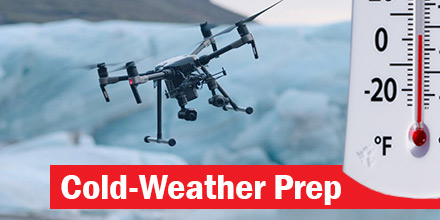23Jan
5 Tips for Flying Drones in Cold Weather
 Flying drones in cold weather is not an issue for many operators. After all, there is not much that keeps them from flying, even extremely cold weather.
Besides rain and high winds, a drop in temperature is usually not enough to keep a pilot grounded.
Today, a majority of multi-rotors can withstand temperatures ranging from 32-145 degrees Fahrenheit. For specific thresholds, check the user manual which came with the drone. However, drone operations in cold-weather do require adequate preparation.
Flying drones in cold weather is not an issue for many operators. After all, there is not much that keeps them from flying, even extremely cold weather.
Besides rain and high winds, a drop in temperature is usually not enough to keep a pilot grounded.
Today, a majority of multi-rotors can withstand temperatures ranging from 32-145 degrees Fahrenheit. For specific thresholds, check the user manual which came with the drone. However, drone operations in cold-weather do require adequate preparation.
Tip #1: Avoid Ice Build-Up
Of course, there are a variety of cold-weather conditions that could endanger a drone's function. However, ice is one of the biggest issues an operator needs to guard against. At all costs, avoid any ice build-up on the device. If a drone’s wings or propellers become covered by ice, it can alter its load distribution and thereby affect its aerodynamics. Condensation is of particular concern. In cold-weather flights, freezing air flows over the warm body of the drone which can form into condensation. It can then settle and freeze on the surface of the drone affecting the UAVs flight performance. Furthermore, when the ice melts it can cause further damage by seeping into the drone’s internal electronics.Tip #2: Keep an Eye Out for Rain
Unless a pilot is aware and confident in the drones overall IP-rating, it is simply good practice to avoid flying in rainy conditions. Obviously, drones are machines made up of various electrical components. As such, these components are affected by moisture just like any other electronic. Water can seriously damage motors, camera’s and other parts. If caught in rain or snow, cease operations immediately and remove any water by wiping down the drone.Tip #3: Remember the Batteries
Cold weather impacts batteries differently than warm weather. As such, batteries need to be adjusted accordingly. In cold weather, the chemical response within the battery slows. This results in the reduction of flight time. Depending on the temperature, flight time can reduce by up to 20%. Extreme drops in temperature can also result in a sudden reduction in power. In some instances, extreme temperatures can result in complete battery failure. Best practices for cold-weather battery care include:- Fully charge all batteries
- Pack spare batteries
- Store batteries in a warm place
- Hover on the spot after take-off
- Take it easy on the throttle when flying
- Take a portable charger

